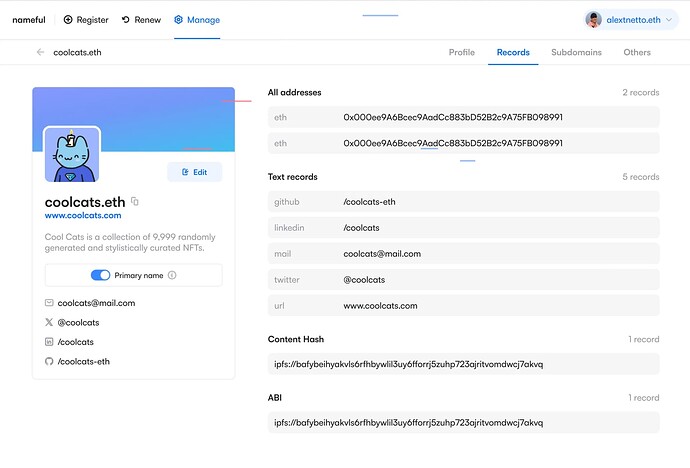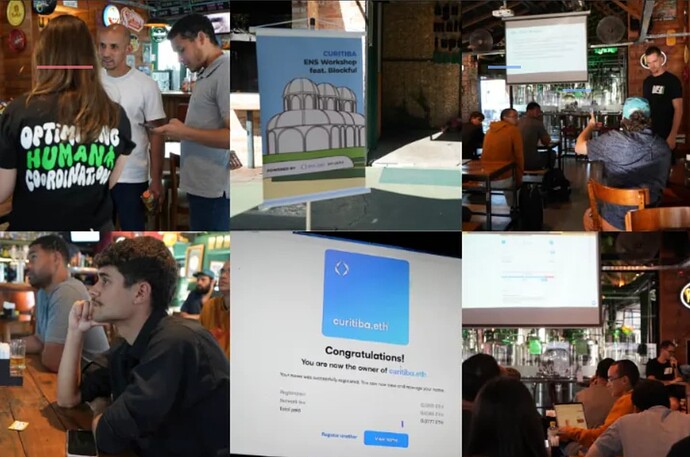Q3 Report
Summary
Building on our previous achievements, we’ve made significant progress in implementing and standardizing off-chain and L2 resolvers. We continue to prioritize creating solutions and standards that enhance the user experience and developer experience across the ENS ecosystem.
Major Updates and Achievements
ENSIP: Wildcard Writing Interface
We’ve drafted an ENSIP that proposes a standardized Wildcard Writing interface for registering and managing offchain domains within the ENS ecosystem.
Key aspects of the ENSIP include:
- Standardized Methods: The proposal outlines methods for domain registration, transferring, and setting records, ensuring a consistent approach to offchain domain management.
- L1 Resolver as entrypoint: The specification uses the Resolver deployed on Ethereum as an entry point for offchain calls, redirecting these calls to the respective destination (L2 or database). The same approach was used by the well-established CCIP-Read.
- Support for Database and L2 Implementations: The ENSIP provides considerations for both database and Layer 2 implementations, allowing for flexible offchain storage solutions.
- Key Functions:
registerParams: For obtaining registration parametersregister: For registering subdomainstransfer: For transferring domainsmulticall: For batch operations on ENS recordscommit: For enabling the commit/reveal strategy for offchain subdomain
- Integration with existing standards: The proposal leverages EIP-5559 for offchain writing and maintains compatibility with existing ENS components.
This ENSIP represents a significant step forward in standardizing offchain domain management within the ENS ecosystem. It provides a framework that will enable consistent implementation across various offchain storage solutions, improving interoperability and user experience.
We aim for going from a protocol-based client implementatation to a standardized version of it, dramatically reducing the complexity required from the client.
Integration with Major Ecosystem Players
A standard has no value if there is no adoption. Our latest efforts are around validating and building it with the ecosystem:
- Coinbase
- Namespace
- Linea
- ENS Labs
The integration process is ongoing, at various stages, between feedback and testing. We’re focusing on maintaining consistency with existing ENS standards while adapting to the unique features of each platform, exploring potential synergies between different approaches to create a more robust and versatile interface.
Deployment of ENS Contracts on Arbitrum
We’ve successfully deployed the ENS contracts on Arbitrum as a proof of concept for the Wildcard Writing L2 implementation. This interim step marks a significant milestone in our efforts to extend ENS functionality to Layer 2 solutions and serves as a valuable testing ground. The lessons learned from this implementation will be invaluable in ensuring these standards can be used in different use cases, players, and can also be integrated into the upcoming ENS architecture.
Key aspects of this deployment:
- Successful implementation of ENS contracts on Arbitrum
- Validation of EIP-5559 L2 implementation in a real-world scenario
- Establishment of a foundation for future L2 and database integrations
Indexing of ENS Events on Arbitrum
We’ve successfully indexed ENS events on Arbitrum, which are now used for the ENSIP-16 Metadata API for Arbitrum. This development enhances our ability to retrieve off-chain ENS data efficiently. By indexing events on Arbitrum, we’ve extended the functionality of the Metadata API to L2 environments, improving the client’s data fetching of offchain domains.
Implications of this achievement:
- Enhanced data retrieval capabilities for L2 implementations
- Enable the nameful (our dapp) integration with domains stored on Arbitrum
User-Facing Developments
The nameful dapp has seen substantial improvements, now handling both L2 and database registering and management of subdomains. This enhancement provides users with a more comprehensive and flexible tool for managing their ENS domains across different environments.
Key improvements include:
- Support for L2 subdomain registration and management
- Standardization of the database-stored domains with the same interface as the L2
- Enhanced user interface for managing domains across different storage solutions
Community Education
We conducted a meetup and workshop about Web3 and ENS at the Curitiba Blockchain Weekend. This initiative continues our commitment to educating and involving communities in the ENS and Ethereum ecosystems, with a particular focus on expanding our reach in Latin America.
This initiative was made possible thanks to the Gitcoin round funding. The whole summary of the event can be found at the Blockful’s blog.
Key highlights:
- Introduced ENS concepts to a broader audience
- Provided hands-on experience with ENS tools and interfaces
- Debate regarding governance
- Gathered feedback from potential users and developers in the Latin American blockchain community
Looking Ahead
Our current focus is on integrating our developed standards with major players’ implementations and gather feedback from the ENS community. This effort aims to increase adoption of our standardized approaches and further unify the ENS ecosystem.
We remain committed to:
- Refining and promoting the off-chain and L2 standards based on community feedback and real-world implementation experiences.
- Expanding partnerships and integrations to increase ENS adoption.
- Further developing and promoting the ENSIP for Wildcard Writing interface.
- Enhancing our user-facing tools, like the nameful dapp, to provide seamless management of ENS domains across different storage solutions.
We’re grateful for the ongoing support of the ENS DAO and community. We look forward to further collaboration as we work together to enhance and expand the ENS ecosystem.

